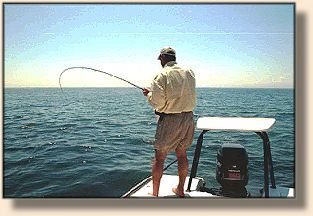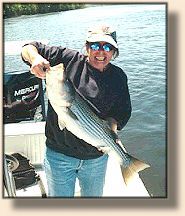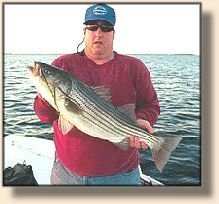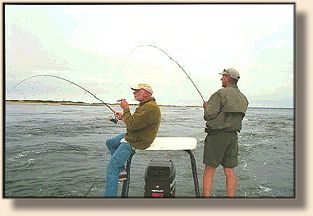Spring has started to raise water temperatures in some of are local rivers
here in Connecticut. Fly fishermen are getting out and taking fish in the
Housatonic, Connecticut and Thames rivers. Striped Bass that have wintered in
these waters are eager to take a well-presented fly. As spring on the
Connecticut coastline continues, expect to find large schools of migratory
baitfish invading Long Island Sound. They come here every year to spawn in
our rivers and bays.

The movement of these small baitfish up the northeast
coast will trigger the spring migration of Striped bass from their winter
spawning grounds. Smaller Striped bass will show up first, some time in May
and the larger fish in the beginning of June. These fish will be eager to
feed when they first arrive; to replenish their energy spent on the long trip
north. About 80% of our Striped bass spawn in the Chesapeake and the other
20% spawn in the Hudson River, that is why conservation in these areas is so
important to our fishery here in the northeast.
 I will start my year in the lower Housatonic River and fish from the Derby
Dam in Shelton to the mouth of the river in Stratford, where it meets Long
Island Sound. There are a number of good Spring fishing spots in the lower
river. The state-launching ramp under the I-95 bridge in Milford is an
excellent spot from mid April to the end of May. Just south of the ramp there
is a sandy flat, where fly fishermen can wade out to the channels edge and
cast to Striped bass suspended in the water column just past the drop off.
I will start my year in the lower Housatonic River and fish from the Derby
Dam in Shelton to the mouth of the river in Stratford, where it meets Long
Island Sound. There are a number of good Spring fishing spots in the lower
river. The state-launching ramp under the I-95 bridge in Milford is an
excellent spot from mid April to the end of May. Just south of the ramp there
is a sandy flat, where fly fishermen can wade out to the channels edge and
cast to Striped bass suspended in the water column just past the drop off.
The best time to fish this area from shore is two hours after high tide to
low tide, this is about a four hour window. Caution must be taken any time
you wade out in the river to fish; the Housatonic is a tidal estuary of Long
Island Sound and is influenced severely by the Sounds tidal movements. I
recommend casting the fly upstream, letting it sink to the bottom, strip in
enough line to stay connected with the fly, as it drifts down stream; when
the fly rounds out start a slow retrieve. I use fast sinking lines and have
found that chartreuse and white, olive and white clousers work the best in
early spring.
 Another good spot is Smiths Point in Milford; you can access
this area at the end of Milford point road in Milford. Just park in the
Audubon parking lot and walk out to the point at the rivers edge, there is a
large sand flat that you can wade out on and fish. This is an excellent spot
to fish in late spring to the end of November.
Another good spot is Smiths Point in Milford; you can access
this area at the end of Milford point road in Milford. Just park in the
Audubon parking lot and walk out to the point at the rivers edge, there is a
large sand flat that you can wade out on and fish. This is an excellent spot
to fish in late spring to the end of November.
On the other side of the river, about a half-mile south of Smiths Point
is a park called Short Beach; you can access this area from South Main
St. in Stratford. Short Beach offers a very large sand flat that runs
parallel to the river channel. Fishermen can wade and fish almost a
mile or so from the beach and out to the river mouth.
Close attention must be paid to the tide here, you can fish this spot two
hours after high tide working your way out as the tide falls and then work
your way back as the tide starts to rise.

I always recommend using a compass when you wade out in to large
areas like this, the fog can roll in very quickly and catch you off guard.
This is an excellent spot all season, in the spring, fish on the channel's
edge, and as the water warms up the flats fishing can be excellent.
In the warmer months, I like to use floating lines and poppers to
take large Bluefish and Striped bass on the surface here.
Casting to rising fish has always been one of my favorite ways of
fly-fishing. Red and white cork poppers, Joe Blados's Crease Fly and Bob's
Banger work well for this type of fishing.
One method I use with my clients is to cut all the hooks off a spinning
rod popper, and cast this plug at different angles, covering as much
of the surface as possible. When a fish chases the popper on the surface,
I ask my client to cast at the rising fish and start stripping. At this time,
I will pull the popper away from the fish to focus the fishes attention
on the fly. This is a good technique to seek out fish not yet feeding
on the surface. It takes a little practice to master
but it is the most rewarding way to take fish on a fly.
~ Bob
About Bob:
Bob is a USCG Licensed Captain and fly-fishing guide from Stratford
CT, and owner of North Coast Charters, just 45 minutes from
New York City. He specializes in saltwater Fly and Light
Tackle Charters. He fishes coastal Connecticut and Southern
Rhode Island for Striped Bass, Bluefish, Bonito and False
Albacore. You can reach him at (203) 378-1160.
|

